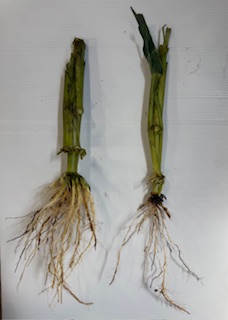Gearing up for Fungicide Season
posted
by Makayla Bueltel on 7/7/2025
in
Weekly Newsletter
.png)
Crops continue to advance in maturity with many corn fields beginning to tassel. Most soybeans are in the R1 to R2 growth stages and we would expect to see some early maturity beans reach R3 by mid/late next week. Optimal fungicide timing on soybeans is R3. For help in identifying if soybeans have hit the R3 growth stage refer to the link. Optimal fungicide timing on corn is at full tassel. We have seen some early applications taking place in corn. Application timing on corn is a balance between spraying ahead of disease development but not so early that we run out of protection during peak grain fill. It continues to be our recommendation to hold off spraying corn until full tassel.
2025 Fungicide Program:
Herbers Ag is again offering aerial application of fungicide and insecticide. For soybeans, ground application is also available. Our lead offering for corn is Veltyma. For soybeans our lead offering is Revytek. Miravis Neo, Aproach Prima, Headline Amp and generic offerings are also available.
Corn: Soybeans:


For more information or if interested in fungicide application, please contact Mike Herbers or Gabe Rowley
Agronomy Update
Jeff Morey, AgriGold Sales Agronomist, identifies key factors to look for as disease and insect pressure ramp up. He also provides a mapping tool to watch the spread of tar spot across the state of Iowa as it has been spotted in both Audubon and Guthrie County. To hear what Jeff Morey has to say about disease and insect pressure reference his monthly newsletter here.
Some things to consider when scouting for tar spot is:
- Black, raised spots on leaves unable to wipe off
- Appears on lower leaves first
- Humid, wet conditions can increase the development
Disease and Insect Pressure:
As fungicide and insecticide season are here, we need to be aware of some of the diseases and insects that can cause severe yield loss. Consider reviewing our fungicide and insecticide programs for this year to help minimize the risk.
Corn Rootworm:

Rootworm hatch occurred several weeks ago and larvae have been feeding on corn roots since then. In the absence of a wind event or digging roots, rootworm larval feeding often goes unnoticed. The photo above was taken from a third-year corn on corn field in Audubon county that root lodged during a recent storm. On the left is Hoegemeyer 8366V (Vorceed) which provides the latest RNAi technology to fight against rootworm pressure. The plant on the right contains the Qrome rootworm trait. As you can see, there is rootworm feeding on the Vorceed hybrid, but severe feeding on the Qrome hybrid. It continues to be our recommendation to use the newest trait technology along with insecticide in corn/corn fields. There were rootworm beetles present in the field from recently pupated larvae. With this level of root injury, the field should continue to be monitored for silk clipping by rootworm adults (beetles). If severe enough, the silk clipping can interfere with pollination. Vorceed from Corteva and SmartStax Pro from Bayer each contain RNAi technology. Qrome from Corteva, SmartStax from Bayer and Duracade from Syngenta do not contain RNAi technology.
Soybean Gall Midge:
Several weeks ago we began to notice dying plants, especially on field edges. Splitting the stems just above the soil surface indicated the presence of the bright orange gall midge larvae. We have also noticed feeding by gall midge that has not resulted in plant death now but has weakened the stem which may result in breakage later with a wind event. Gall midge is difficult to manage with no consistent, effective treatments available. Seed treatments have no effect. Expect to see another round of larval feeding and plant death beginning in 3-4 weeks. Damage this year appears to be similar to 2024 and less than the dry year of 2023.
- Increased risk near field edges and waterways
- Cracks in stem must be present in order for infestation to occur
- Larvae appear initially clear but then turn bright orange
- Adults start emerging from soil in June
For more information on how to identify soybean gall midge and images reference the link.
White Mold:
The recent wet weather during soybean flowering sets the stage for white mold infection. Sclerotia from previous year's infections germinate in the soil and form apothecia that release spores that infect soybean plants, mainly though senescing flowers. These spores grow in the soybean plant stem to create more sclerotia. In the process, they disrupt the vascular system of the plant, resulting in death. Infection is occurring now but will not manifest into dead plants for several weeks. Dying plants will have water-soaked lesions and/or fluffy white fungal growth, usually about a foot from ground level. White Mold is very difficult to control. Fungicides that have shown some benefit include Endura and Viatude. Timing is critical and may require several applications. We have been very diligent in selecting soybean varieties that have decent white mold tolerance which is the first line of defense.